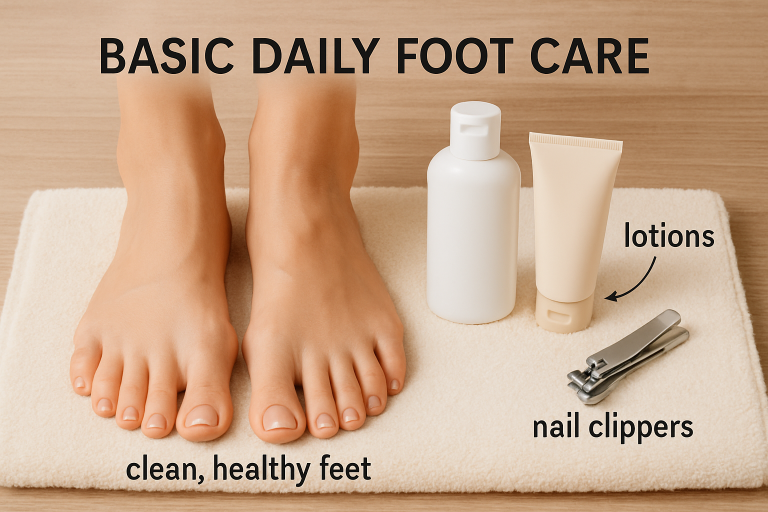Why Foot Health Matters
Our feet support us every step of the way, whether we’re running errands, chasing after kids, or pursuing athletic goals. The well-being of your feet underlies your entire body’s mobility, balance, and comfort. As highlighted by professionals such as a Lackawanna podiatrist, even minor issues can quickly develop into conditions that affect quality of life if not properly managed. Being proactive with foot care helps prevent painful complications and keeps you moving confidently.
Many people only notice their feet when pain occurs, but healthy habits established early on can spare you from common problems down the road. Foot wellness isn’t just a matter of aesthetics—it’s about ongoing performance, injury prevention, and enjoying an active lifestyle at every age. Considering how much stress our feet handle, consistent care becomes essential to a healthy daily routine.
Daily Foot Care Basics
A simple daily routine goes a long way in promoting foot comfort and hygiene. Start by washing your feet with soap and warm water, paying special attention to dry well between the toes. This prevents both odor and infection. After drying, apply a moisturizer to the tops and bottoms of your feet, but be sure to avoid the spaces between your toes to reduce the risk of fungal growth. Regularly trimming toenails straight across is key to avoiding ingrown toenails and other nail issues. Take a moment daily to visually inspect your feet for blisters, small cuts, or changes in skin color—these simple checks can help you catch problems before they become bigger concerns.
- Wash and dry feet thoroughly every day.
- Apply moisturizer to prevent dryness—but not between toes.
- Trim nails straight to avoid ingrown toenails.
- Inspect skin for changes each morning or night.
Practicing this straightforward self-care not only preserves the health of your feet but also helps you stay attuned to any emerging issues. In particular, people with diabetes or those with diminished circulation should be especially vigilant, as unnoticed sores can escalate quickly.

Choosing the Right Shoes for Comfort
Shoe selection plays a critical role in foot wellness. Prioritize shoes that offer firm arch support, plenty of toe room, and cushioning that matches your activity level. Footwear that’s too tight, unsupportive, or worn out can cause or aggravate conditions like bunions, plantar fasciitis, and even contribute to overall joint pain. A well-chosen pair of shoes helps evenly distribute weight across your foot and cushion impact, whether walking around town or standing for long stretches. For expert guidance on shoe selection, the New York Times Wirecutter guide to walking shoes provides in-depth reviews and advice for various needs and preferences.
Watching for Early Warning Signs
Paying attention to how your feet look and feel each day is crucial. Early warning signs—such as persistent pain, swelling, discoloration, thickened nails, or numbness—can indicate underlying concerns ranging from injury and infection to circulatory or nerve issues. Ignoring seemingly minor symptoms worsens problems and can even lead to reduced mobility. Address issues early: Don’t hesitate to seek a professional evaluation when something doesn’t seem right, especially for those managing chronic conditions.
Staying Active Without Injuring Your Feet
Physical activity strengthens your feet and keeps them supple, but sensible precautions are necessary to avoid strain. Alternate between high- and low-impact exercises—if you enjoy running, consider integrating swimming or cycling into your routine. Stretching the foot and calf muscles before and after exercise reduces your risk of Achilles tendonitis and plantar fasciitis, two common sources of foot pain. Gradual progression in the intensity and duration of your activities gives your feet time to adapt and recover, preventing overuse injuries.
- Warm up and stretch before heavy activity.
- Don’t ignore pain—rest and address issues early.
- Alternate activity types to avoid overuse.
If you develop foot pain, allow time for healing instead of pushing through. Rest, ice, compression, and elevation can help with minor issues, but persistent discomfort warrants a professional assessment. Consistency in movement and mindful rest is key to keeping your feet healthy in the long term.
Seasonal Foot Care Tips
Changing seasons introduce different challenges for foot care. During hot weather, keep your feet cool and protected by choosing breathable shoes and applying sunscreen to exposed skin. Sandals can increase the risk of dryness and calluses, so remember to moisturize regularly and cleanse your feet thoroughly. In colder months, warmth and dryness become priorities. Choose moisture-wicking socks and insulated footwear, and address wet socks or cold feet immediately to avoid conditions like fungal infections or frostbite. Adapt your foot care routine to seasonal shifts to keep your feet safe and comfortable in any climate.
When to Seek Professional Advice
If you notice ongoing pain, pronounced swelling, visible deformities, or signs of infection such as redness and pus, it’s wise to seek prompt attention from a foot specialist. Timely professional care can prevent minor inconveniences from becoming chronic or severe problems. For those with risk factors like diabetes, neuropathy, or vascular disease, regular checkups are essential regardless of symptoms. Proper diagnosis and early intervention often lead to better outcomes, faster healing, and ultimately less downtime.
Caring for your feet is vital to maintaining mobility, balance, and well-being. Proper hygiene, supportive footwear, and routine attention can prevent discomfort and long-term issues. Small, consistent steps in daily care protect foot health and contribute to a more active, confident lifestyle.